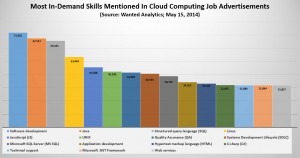Cloud Employment Figures Provide Insight into Current Trends
 New figures on cloud computing employment reveal where businesses are most focusing efforts today. The information, which was compiled by a Forbes contributor using Wanted Analytics’ dashboard, scanned all cloud-related jobs and found certain areas are generating more employee demand than others.
New figures on cloud computing employment reveal where businesses are most focusing efforts today. The information, which was compiled by a Forbes contributor using Wanted Analytics’ dashboard, scanned all cloud-related jobs and found certain areas are generating more employee demand than others.
Top Skills
Software dominates cloud job postings, with the top job postings during the survey period being software development and JavaScript. Structured Query Language (SQL) and Linux are also in high demand. The high number of software development postings is in line with the rapid growth of Software-as-a-Service (SaaS) solutions in most industries, as businesses grow more comfortable with using cloud-based solutions.
Top Employers
Cloud hosting providers are the top employers seeking cloud workers, with Amazon heading up the list. Microsoft follows, with both companies competing aggressively for the best in the business. Both companies often recruit recent college graduates to their respective campuses where they’re encouraged to help create innovative solutions to meet business needs today. In addition to cloud hosting providers, major corporations like Deloitte, Lockheed Martin, and Northrop Grumman are regularly seeking large numbers of technology workers in the cloud services sector.
Top Locations
Washington, D.C. is the most popular candidate location among employers, but there is also a high candidate supply in that area. New York City and Seattle, Washington also have both high supply and demand for cloud technology jobs. Perhaps most interesting is that areas like Santa Clara and San Francisco, California, and Baltimore, Maryland have a higher demand for jobs than candidates to fill them. This shortage could mean good news for current graduates but bad news for the companies relying on cloud services in those areas.
As cloud computing continues to become a part of business today, demand for skilled professionals will only continue to increase. These trends show that software is a large part of how businesses are using the cloud today, but will software continue to dominate well into the future? Or will infrastructure take over the demand?
